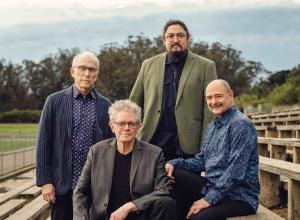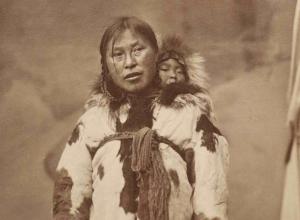Opening March 4: First Major International Exhibition of Sally Mann's Work of the South
 Washington, DC—For more than 40 years, Sally Mann (b. 1951) has made experimental, elegiac, and hauntingly beautiful photographs that explore the overarching themes of existence: memory, desire, death, the bonds of family, and nature's magisterial indifference to human endeavor. What unites this broad body of work—figure studies, landscapes, and architectural views—is that it is all bred of a place, the American South. Using her deep love of her homeland and her knowledge of its historically fraught heritage, Mann asks powerful, provocative questions—about history, identity, race, and religion—that reverberate across geographic and national boundaries.
Washington, DC—For more than 40 years, Sally Mann (b. 1951) has made experimental, elegiac, and hauntingly beautiful photographs that explore the overarching themes of existence: memory, desire, death, the bonds of family, and nature's magisterial indifference to human endeavor. What unites this broad body of work—figure studies, landscapes, and architectural views—is that it is all bred of a place, the American South. Using her deep love of her homeland and her knowledge of its historically fraught heritage, Mann asks powerful, provocative questions—about history, identity, race, and religion—that reverberate across geographic and national boundaries.
Sally Mann: A Thousand Crossings, the first major survey of this celebrated artist to travel internationally, investigates how Mann's relationship with her native land—a place rich in literary and artistic traditions but troubled by history—has shaped her work. The exhibition brings together 115 photographs, many exhibited for the first time. On view in the West Building of the National Gallery of Art, Washington, from March 4 through May 28, 2018, the exhibition is accompanied by a fully illustrated catalog, presenting an in-depth exploration of the evolution of Mann's art, and a short film highlighting her technical process.
"In her compelling photographs, Mann uses the personal to allude to the universal, considering intimate questions of family, memory, and death while also evoking larger concerns about the influence of the South's past on its present," said Earl A. Powell III, director, National Gallery of Art, Washington. "With the acquisition of works from the Corcoran Gallery of Art in 2014, the National Gallery is now one of the largest repositories of Mann's photographs. We are grateful for the opportunity to work closely with the artist in presenting a wide selection of the work she has created over four decades."
Exhibition Support
The exhibition is supported by a generous grant from the Trellis Fund. Additional support is provided by Sally Engelhard Pingree and The Charles Engelhard Foundation.
Exhibition Organization and Curators
The exhibition is organized by the National Gallery of Art, Washington, and Peabody Essex Museum, Salem, Massachusetts.
The exhibition is curated by Sarah Greenough, senior curator and head of the department of photographs, National Gallery of Art, and Sarah Kennel, The Byrne Family Curator of Photography, Peabody Essex Museum.
Exhibition Tour
*National Gallery of Art, Washington, March 4-May 28, 2018 *Peabody Essex Museum, Salem, June 30-September 23, 2018
*The J. Paul Getty Museum, Los Angeles, November 20, 2018-February 10, 2019
*Museum of Fine Arts, Houston, March 3-May 27, 2019
*Jeu de Paume, Paris, June 17 -September 22, 2019
*High Museum of Art, Atlanta, October 19, 2019 -January 12, 2020
Exhibition Highlights
The seeds for Sally Mann: A Thousand Crossings were planted in 2014, when National Gallery of Art curators undertook a review of photographs from the Corcoran Gallery of Art after its collections were placed under the stewardship of the National Gallery. Among the Corcoran's works were 25 photographs by Sally Mann, made from the mid-1970s to the early 2000s. With the addition of these works, plus several more acquired through purchase, the National Gallery became one of the largest public repositories of Mann's photographs in the country. The curators' interest in mounting an exhibition of Mann's art deepened when they realized that despite her immense talent and prominence, the full range of Mann's work had not yet received sufficient and widespread scholarly and critical attention.
Sally Mann: A Thousand Crossings is organized into five sections—Family, The Land, Last Measure, Abide with Me, and What Remains. The exhibition opens with works from the 1980s, when Mann began to photograph her three children at the family's remote summer cabin on the Maury River near Lexington, Virginia. Taken with an 8 x 10 inch view camera, the family picturesrefute the stereotypes of childhood, offering instead unsettling visions of its complexity. Rooted in the experience of a particular natural environment—the arcadian woodlands, rocky cliffs, and languid rivers—these works convey the inextricable link between the family and their land, and the sanctuary and freedom that it provided them.
The exhibition continues in The Land with photographs of the swamplands, fields, and ruined estates Mann encountered as she traveled across Virginia, Georgia, Louisiana, and Mississippi in the 1990s. Hoping to capture what she called the "radical light of the American South," Mann made pictures in Virginia that glow with a tremulous light, while those made in Georgia and Mississippi are more blasted and bleak. In these photographs, Mann was also experimenting with antique lenses and the 19th-century collodion wet plate process and printing in a much larger size (30 x 38 and 40 x 50 inches). The resulting photographic effects, including light flares, vignetting, blurs, streaks and scratches, serve as metaphors for the South as a site of memory, defeat, ruin, and rebirth. Mann then used these same techniques for her photographs of Civil War battlefields in the exhibition's third section, Last Measure. These brooding and elusive pictures evoke the land as history's graveyard, silently absorbing the blood and bones of the many thousands who perished in battles such as Antietam, Appomattox, Chancellorsville, Cold Harbor, Fredericksburg, Manassas, Spotsylvania, and the Wilderness.
The fourth section, Abide with Me, merges four series of photographs to explore how race and history shaped the landscape of Virginia as well as Mann's own childhood and adolescence. Expanding her understanding of the land as not only a vessel for memory but also a story of struggle and survival, Mann made a series of starkly beautiful tintypes between 2006 and 2015 in the Great Dismal Swamp—home to many fugitive slaves in the years before the Civil War—and along nearby rivers in southeastern Virginia where Nat Turner led a rebellion of enslaved people on August 21, 1831. Here, Mann's use of the tintype process—essentially a collodion negative on a sheet of darkened tin—yields a rich, liquid-like surface with deep blacks that mirror the bracken swamp and rivers. Merging her techniques with metaphoric possibilities, she conveyed the region's dual history as the site of slavery and death but also freedom and sanctuary. Mann also photographed numerous 19th-century African American churches near her home in Lexington. Founded in the decades immediately after the Civil War when African Americans in Virginia could worship without the presence of a white minister for the first time, these humble but richly evocative churches seem alive with the spirit that inspired their creation and the memories of those who prayed there.
Also included in Abide with Me are photographs of Virginia "Gee-Gee" Carter, the African American woman who worked for Mann's family for 50 years. A defining and beloved presence in Mann's life, Carter was also the person who taught Mann the profoundly complicated and charged nature of race relations in the South. The final component of this section is a group of pictures of African American men rendered in large prints (50 x 40 inches) made from collodion negatives. Representing Mann's desire to reach across "the seemingly untraversable chasm of race in the American South," these beautiful but provocative photographs examine an "abstract gesture heated up in the crucible of our association," as Bill T. Jones, who in part inspired the series, once said.
The final section of the exhibition, What Remains, explores themes of time, transformation, and death through photographs of Mann and her family. Her enduring fascination with decay and the body's vulnerability to the ravages of time is evident in a series of spectral portraits of her children's faces and intimate photographs detailing the changing body of her husband Larry, who suffers from muscular dystrophy. The exhibition closes with several riveting self-portraits Mann made in the wake of a grave riding accident. Here, her links to southern literature and her preoccupation with decay are in full evidence: the pitted, scratched, ravaged, and cloudy surfaces of the ambrotypes function as analogues for the body's corrosion and death. The impression of the series as a whole is of an artist confronting her own mortality with composure and conviction.
Sally Mann
Born in 1951 in Lexington, Virginia, Sally Mann continues to live and work in Rockbridge County. Mann developed her first roll of film in 1969 and began to work as a professional photographer in 1972. She attended Bennington College, Vermont, and graduated in 1974 with a BA in literature from Hollins College, Roanoke, Virginia where she earned an MA in creative writing the following year. She has exhibited widely and published her photographs in the books Second Sight: The Photographs of Sally Mann (1983), Sweet Silent Thought: Platinum Prints by Sally Mann (1987), At Twelve: Portraits of Young Women (1988), Immediate Family (1992), Still Time (1994), Mother Land: Recent Landscapes of Georgia and Virginia (1997), What Remains (2003), Deep South (2005), Sally Mann: Photographs and Poetry (2005), Proud Flesh (2009), Sally Mann: The Flesh and the Spirit (2010), and Remembered Light: Cy Twombly in Lexington (2016). Mann's best selling memoir, Hold Still: A Memoir with Photographs (2015), was a finalist for the National Book Award. She has received numerous honors as well as grants from the National Endowment for the Arts, the National Endowment for the Humanities, and the Guggenheim Foundation. In 2011 Mann delivered the prestigious William E. Massey Sr. Lectures in the History of American Civilization at Harvard University.
Catalog and Related Programs
Published by the National Gallery of Art, Washington, and the Peabody Essex Museum, Salem, Massachusetts, in association with Abrams, this richly illustrated monograph constitutes an in-depth exploration of the evolution of Mann's art through its five sections: Family, The Land, Last Measure, Abide with Me, and What Remains. Plate sections are enriched by the inclusion of quotations by Mann herself and by her most beloved authors. Essays by curators Sarah Greenough and Sarah Kennel analyze Mann's photographic development in concert with her literary interests and Mann's family photographs, respectively. In their valuable contributions, Hilton Als, New Yorker staff writer and recipient of the 2017 Pulitzer Prize for Criticism; Malcolm Daniel, Gus and Lyndall Wortham Curator of Photography, The Museum of Fine Arts, Houston; and Drew Gilpin Faust, president and Lincoln Professor of History, Harvard University, explore literary and photographic responses to racism in the South; Mann's debt to 19th-century photographers and techniques; and the landscape as repository of cultural and personal memory. Featuring 230 color illustrations, the 332-page catalog is available in hardcover at shop.nga.gov, or by calling (800) 697-9350 or (202) 842-6002; faxing (202) 789-3047; or emailing mailorder@nga.gov.
Lecture
Introduction to the Exhibition
March 4 at 2:00 p.m.
East Building Auditorium
Sarah Greenough, senior curator and head of the department of photographs, National Gallery of Art
Public Symposium
Sally Mann: A Thousand Crossings
April 14 at 10:30 a.m.
East Building Auditorium
Illustrated lectures by noted scholars
Made possible by the James D. and Kathryn K. Steele Fund for Photography.
Documentary Film
An eight-minute documentary demonstrating Mann's artistic process is screened in the exhibition.
Image: Sally Mann, Oak Hill Baptist 01:01, 2008-2016, gelatin silver print, collection of the artist, image © Sally Mann















